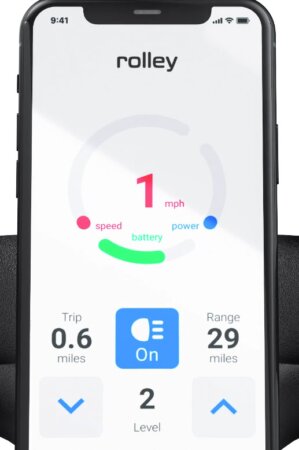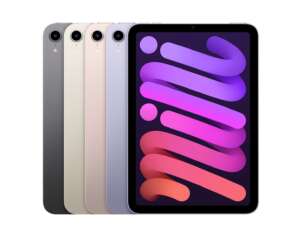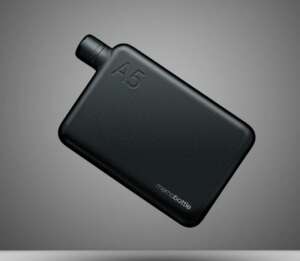The Rolley Scooterson Electric Scooter is a Red Dot Design award winner and is manufactured in Romania by Arsat Industry.
The key feature of the design involves a phone app and modern sensors for ease of use and control, such as proximity activation, acceleration, signalling, locking and security system. The other key features include a swappable battery, and IP65 rating for dust-tight and low-pressure water spray protection, including rain.
Rolley Scotterson is designed as a seated, smart e-scooter with a maximum range of 48 km (38 miles) based on a 73kg (160lbs) rider. The speed limit is adjusted according to the region, which is up to 20 mph for North America, and up to 25 km/h for Europe.
The design appears to evolve from motorbikes that have a different riding style as electric scooters evolved from plain bicycles and push scooters.

Phone App Controls[tie_index]Phone App Controls[/tie_index]
The Rolley Scooterson electric scooter uses the phone for most of its control, which is quite unique.
- It automatically starts when the rider is within the activation range.
- The rider unlocks by using the phone app, using face recognition or a fingerprint sensor.
- The rider first pushes off like riding a regular kick-scooter, which sets the scooter in gear one, the second kick shifts to gear two, then the rider simply sits for gear three.
- Auto-locks when rider leaves activation range.

Rolley+Phone
Initially, we were amazed by the “no gear shifter, nor acceleration lever” and wondered how they are done. Then the marketing video shows the man kicking off the “futuristic” scooter which reminds us of the stone-age Flintstone cartoon.
Fortunately, the marketing video shows a girl sit and ride off without any kicking which the video also explains is done by “pressing the accelerator button” on the left side. This is a better design than kicking.


Sensors[tie_index]Sensors[/tie_index]
The design trends of scooters are showing increasing integration of sensors on an electric scooter, including the highly-rated Unagi Model Eleven (Unagi 11) which we reviewed recently that has collision detection sensors. The Rolley does not have such a collision sensor which we opine is fine. The smaller Unagi 11 requires that as it is smaller and nimble, which makes it easier to go into tight places that may risk a collision.
On the other hand, the Rolley has a temperature sensor for the motor, battery and controller, which are similar to cars or motorbikes where sensors are for the engine. The temperature can get up quickly by fast acceleration or riding up long steep hills, so it is important to note the temperature of the motor when it goes too high.
Another feature that we like is the keyless and share option control via phone app. The scooter owner can lock or unlock the scooter remotely using Face ID, or use the app to share the scooter with his friend.
The more advanced version, Rolley +, has security features such as “Find My Scooter” in case someone decided to carry it away. The weight of 31kg is not designed to be portable for the riders, but it is not too heavy for a thief to drag them away. In that case, the scooter has an anti-theft system that notifies the owner when someone is messing with the scooter. While this was not explicitly stated in the specs, we believe the Rolley has a built-in GPS sensor to facilitate location tracking.
Other sensors include an accelerometer, compass, gyroscope, and G-force.
Form Factor[tie_index]Form Factor[/tie_index]

Our first impression when reviewing Rolley’s design is the look of the “Harley Davidson” style which has a lower seat to handle height.
The form factor belongs to the large, seated electric scooter, designed for road stability and comfortable ride with thicker broad tires and relaxed, low seating position.
There is no suspension, so the rider may feel more of the effect of bumpy, gravel or brick roads, which may be reduced by the broad and thick tires.
The low centre of gravity (CG) design may mean that the rider is less likely to get thrown off if there is a sudden stop or light collision, and the bike is less likely to skid on wet slippery roads.
Material Engineering[tie_index]Material Engineering[/tie_index]
The Rolley does not have the classic, shiny chromed steel handles, but is built with modern reinforced carbon fibre and aircraft-grade aluminium alloy which are both lightweight, durable and free from the worries of rust.
There could still be some components that are made of steel. So the Rolley has a “Salt Spray Test” qualification of 96 hours where the item is subjected to 5% salt mist spray to test the corrosion resistance of the coatings and material.
- Board and Fenders – Carbon Fiber Reinforced Polymer
- Frame Tubes – 3D Formed, Aircraft Grade Aluminum Alloys
- Metallic parts – CNC machined and Low-Pressure Precision Casting
| Welding areas are the weakest points on the frame and can develop cracks and structural failure over time. For Rolley, we used space-age adhesive bonding with powerful force resistance that maintains its integrity even after years of use. |
Structural adhesives have been used in cars and aircraft manufacturing, and one reason for not using them is cost. But the creators spare no expenses and used the method to design the Rolley. Welding involves melting two similar materials together and joining them. Since aluminium is weak, using a strong adhesive to join two aluminium tubes together will be better than welding with aluminium rods.
Motor[tie_index]Motor[/tie_index]
The Rolley uses 750W geared hub motor smaller and gives more torque than direct-drive motors. It has a high torque of 80Nm (first gear) which is quite high for scooters, where the range is normally between 40 to 80Nm. The advantage of such high torque is a faster pickup from stationary (0/ms) with high acceleration.
Power = Torque X Rotational Speed;
High torque will also be useful when beginning the ride on a slope of say 35 to 45 degrees and with a heavy rider. There are 4 levels of speed that can be controlled by the phone app, which is adjustable up to 20 mph max. for North America, and up to 25 km/h max. for Europe.
Battery[tie_index]Battery[/tie_index]
Currently, the battery has a charging time of 3 hours without fast charging, and there is a more powerful charger to be announced. Two specs to highlight for the battery is the <1 hour charging time design target which is under development and the 500 charge cycles which can last up to an estimated 3 years. Obviously, the battery life will depend on the mileage just like any device or vehicle.
- Rated Voltage: 43DCV
- Nominal Capacity: 14Ah (750 Wh)
- Smart Battery Management System (BMS)
- Charging time: (with standard 3A charger): 3h
(faster charging with a more powerful charger, to be announced) - Charging time: (with EnergyBus Charging Station – under development): < 1H
- Max Continuous Discharge Current: 30A
- Cycle Life: 500 charges (3 Years for 200 days of use/year in a normal use-case).
A very convenient feature is the “charging alerts” which send the rider reminders via phone notification when the battery is low.
Brakes and Safety[tie_index]Brakes and Safety[/tie_index]
The Rolley uses mechanical Disk Brakes, which we opine is a better design choice than electric brakes. Disk brakes have great stopping power, work well in wet weather and allow for precise braking that reduces the chance of wheel lock.
For safe riding, the rear has two automatic signalling lights which blink in the direction of turning.
Conclusion[tie_index]Conclusion[/tie_index]
We like the look, torque, stability and advanced features of the phone apps and sensors. Companies can also purchase a fleet of scooters for sharing among co-workers in an industrial or business park.
The maximum range per charge of 48km is quite short and should be improved further by using a bigger battery, and the “kicking” method to accelerate the scooter is unnecessary since there is already an accelerator button.
Reference:
Rolley at Indiegogo
Rolley Scooterson – Red Dot Design Winner
Scooterson Homepage







